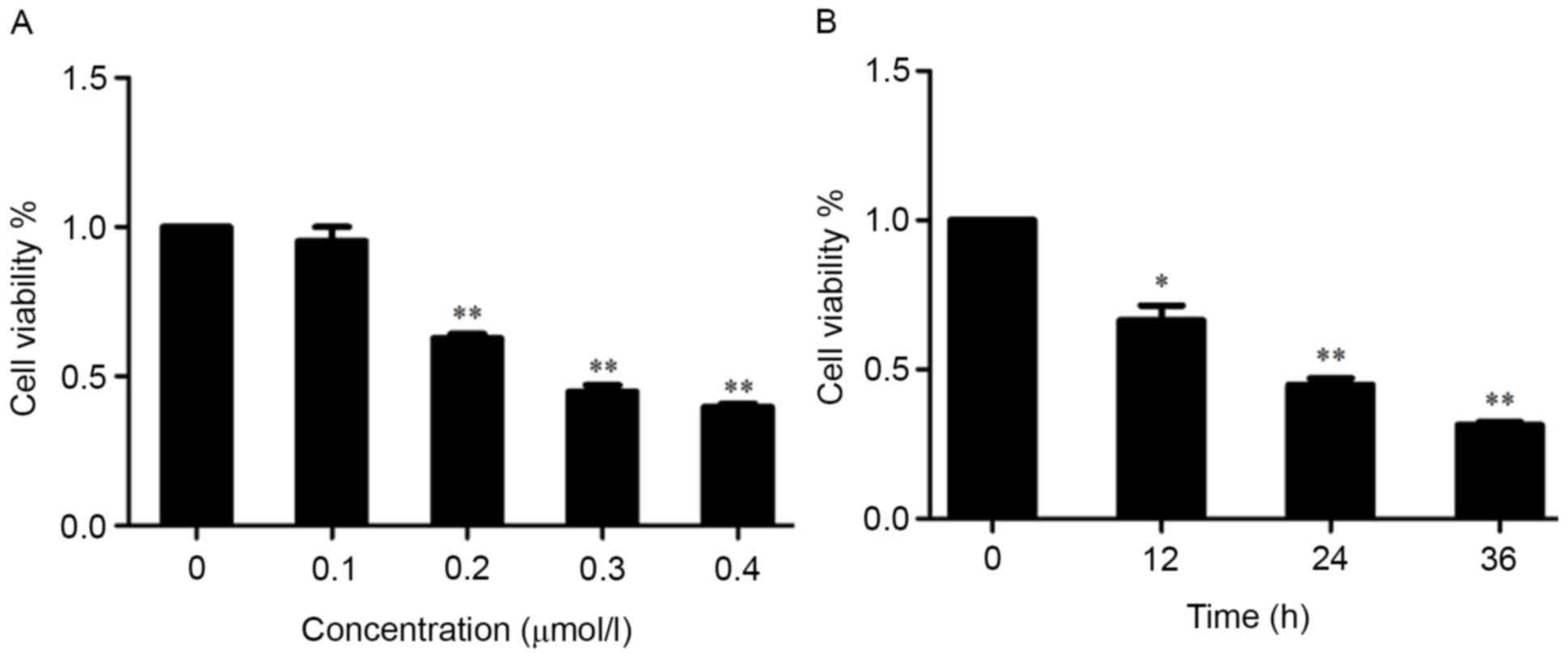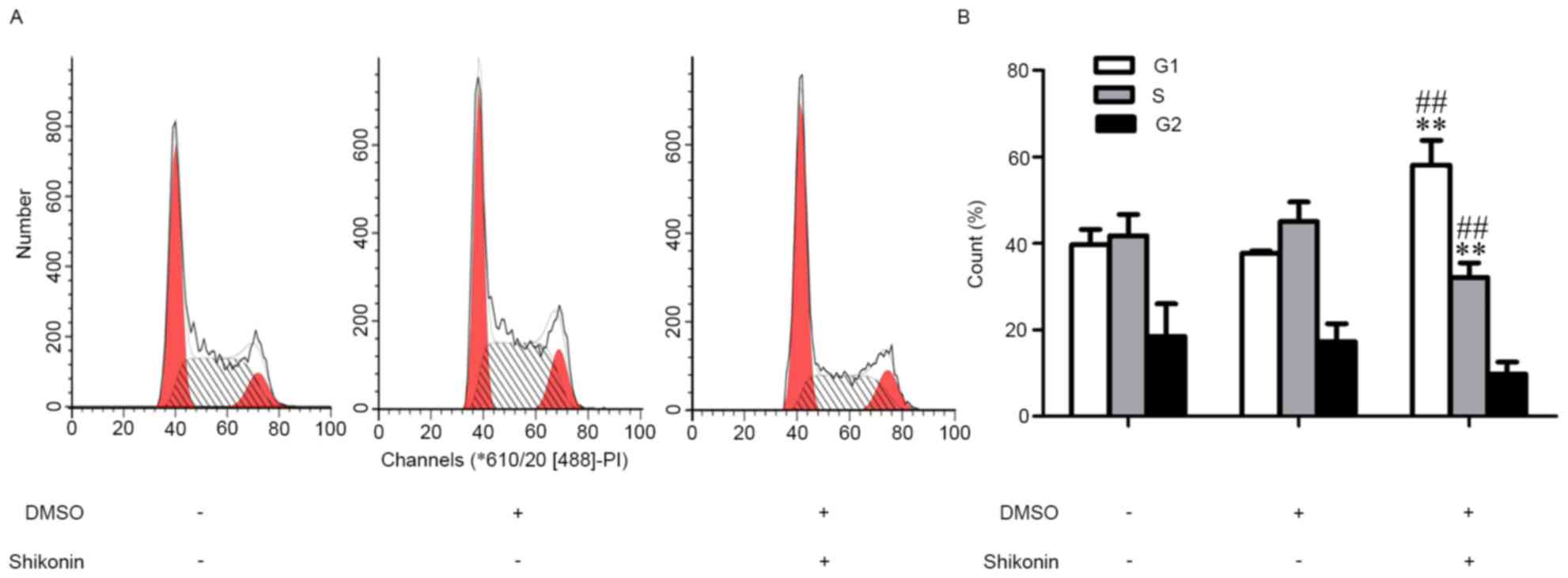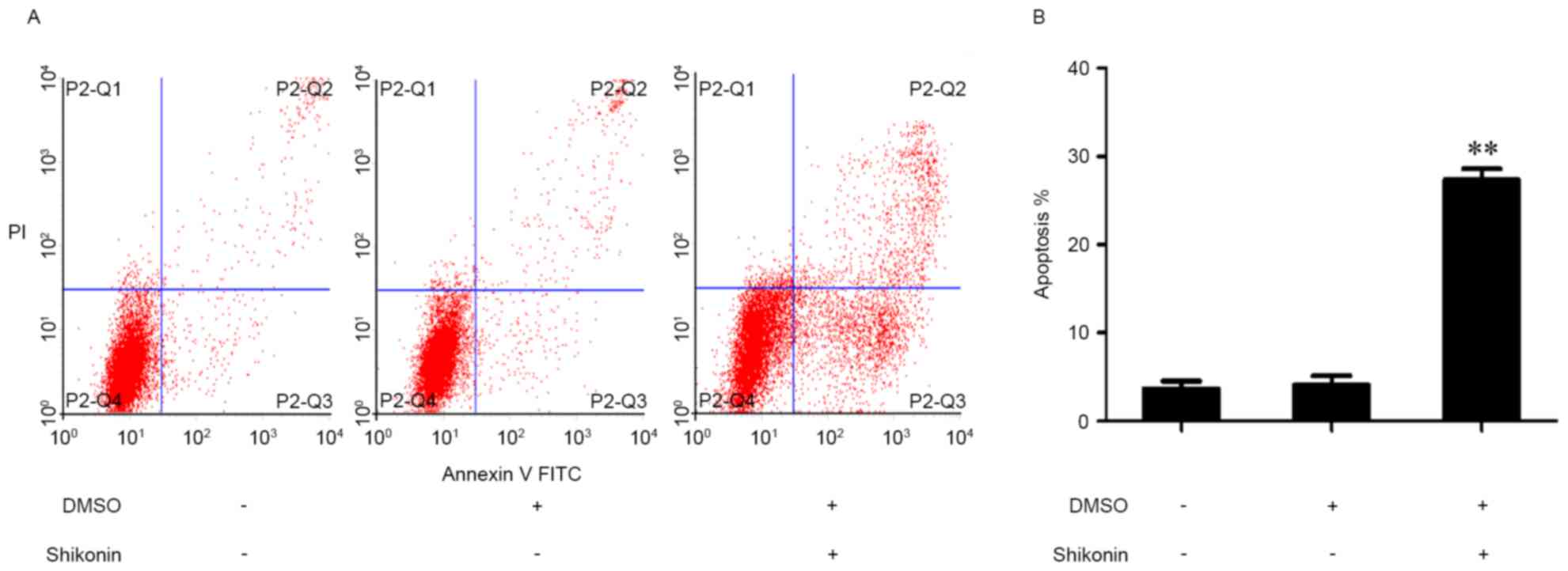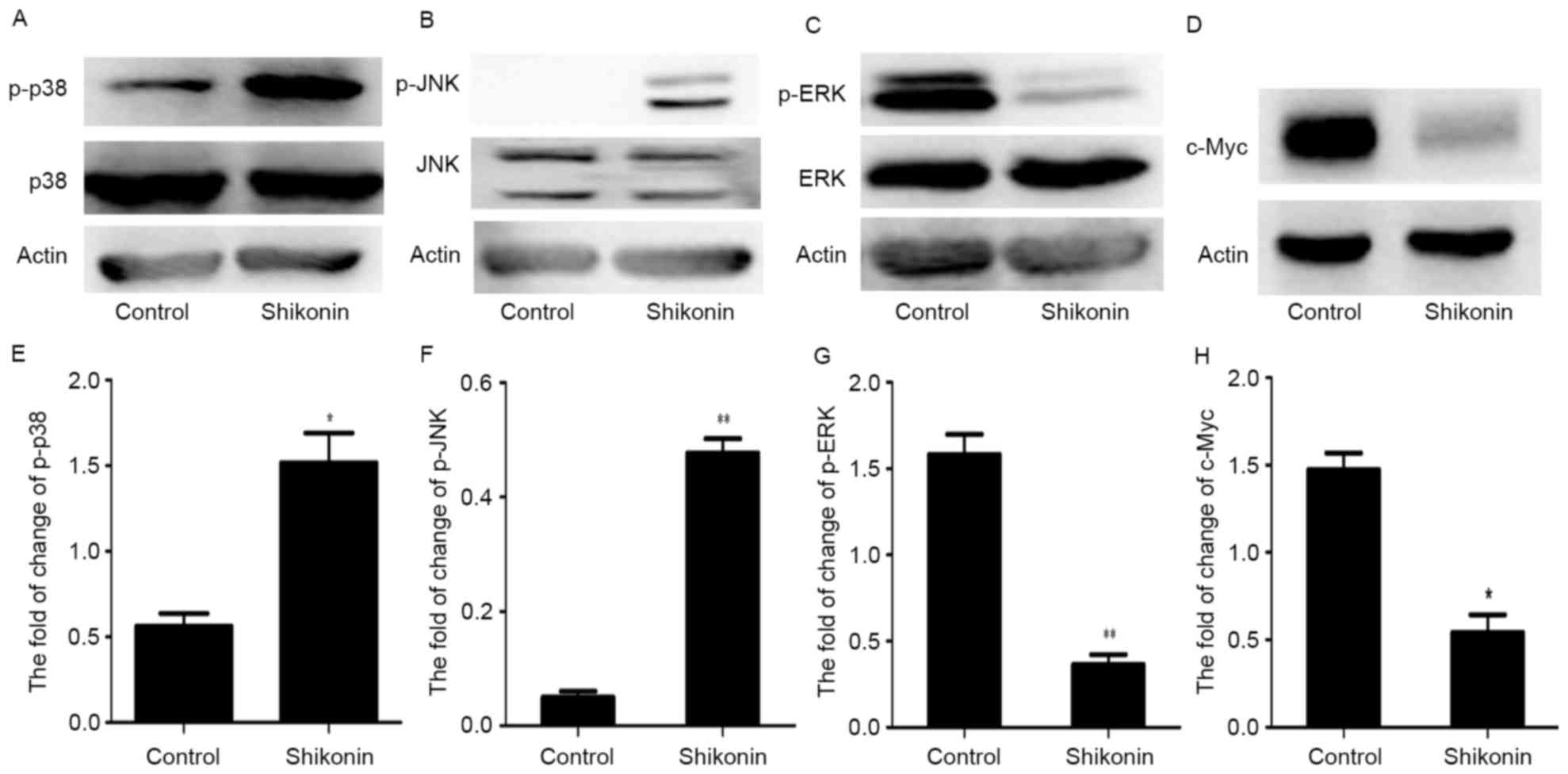Shikonin suppresses proliferation and induces apoptosis in human leukemia NB4 cells through modulation of MAPKs and c‑Myc
- Authors:
- Published online on: July 13, 2017 https://doi.org/10.3892/mmr.2017.6965
- Pages: 3055-3060
-
Copyright: © Shan et al. This is an open access article distributed under the terms of Creative Commons Attribution License.
Abstract
Introduction
Acute promyelocytic leukemia (APL) is a subtype of acute myeloid leukemia accounting for 5–15% of all forms of this disease (1). APL is characterized by a chromosomal translocation [t(15;17)(q24;q21)] resulting in the formation of a retinoic acid receptor α and promyelocytic leukemia (PML-RARα) fusion protein (1–3). All-trans retinoic acid (ATRA) and arsenic trioxide (ATO) are the most important treatments of APL patients and induce a high cure rate. ATRA promotes differentiation and ATO induces apoptosis. Although ATRA and ATO have made APL highly curable, some patients may develop severe side effects. In addition, some APL patients are not sensitive to these compounds (1,4–7). Hence, it is necessary to develop new therapeutic strategies for this disease.
Shikonin, an active component of the Chinese medical herb Zi Cao has been used to treat burns, carbuncles, macular eruptions, measles and sore throats (8,9). In addition to the anti-bacterial and anti-inflammatory activities of this medicine, shikonin inhibits proliferation and induces apoptosis in different cancer cell lines including prostate cancer (10), oral squamous cell carcinoma (11), chronic myelogenous leukemia (12), hepatocellular carcinoma (13) and thyroid cancer (14). Substantial evidence indicates that shikonin induces apoptosis partly through the mitogen-activated protein kinase (MAPK) pathway (12,15).
The MAPK family, that includes extracellular signal-regulated kinase (ERK), p38 MAPK and c-Jun N-terminal kinase (JNK), serves an important role in cell proliferation, cell cycle progression, differentiation, survival and apoptosis (16,17). The ERK pathway is primarily activated by growth factors and mitogens, and is important in cell growth and differentiation (18). p38 MAPK and JNK are mainly responsive to stress signals and inflammatory cytokines, and are associated with apoptosis (19,20).
Accumulating evidence indicates that shikonin exerts antitumor activity in different cancer cells. However, the effects and related mechanism of shikonin on human leukemia NB4 cells are not known. In the present study, the authors investigated the influence of shikonin on the proliferation and apoptosis of NB4 cells and explored the potential mechanisms. The results may be beneficial for developing improved therapies for APL.
Materials and methods
Reagents
Shikonin and dimethylsulfoxide were purchased from Sigma-Aldrich; Merck KGaA, Darmstadt, Germany). The purity of shikonin was >98%. Antibodies against caspase-3, poly ADP-ribose polymerase (PARP), c-Myc, p-ERK1/2, ERK1/2, p38 MAPK, p-JNK and JNK were purchased from Cell Signaling Technology, Inc. (Danvers, MA, USA). The antibody against p-p38 MAPK was purchased from Merck KGaA. Goat anti-rabbit, goat anti-mouse and β-actin antibodies were purchased from Beijing Zhongshan Golden Bridge Biotechnology Co., Ltd. (Beijing, China).
Cell lines and culture
NB4 cells were obtained from the Shanghai Institute for Biological Science, Chinese Academy of Sciences (Shanghai, China) and maintained at 37°C under 5% CO2 in RPMI-1640 (Gibco; Thermo Fisher Scientific, Inc., Waltham, MA, USA) medium containing 10% fetal calf serum (Gibco; Thermo Fisher Scientific, Inc.).
Cell proliferation assays
Cell viability was detected by the Cell Counting Kit (CCK)-8 (Sevenseas Futai Biotechnology Co., Ltd., Shanghai, China) assay. Cells (1×104) were seeded in 96-well plates and treated with increasing concentrations of shikonin for 12, 24 and 36 h. A total of 10 µl CCK-8 solution was added to each well at the end of each culture period. Cells were then incubated for 2 h at 37°C and absorbance of the medium was measured at 450 nm using a spectrophotometer.
Nucleus morphological changes examined by Hochest 33342 staining
Cells (5×105) were seeded in six-well plates and treated with shikonin (0, 0.3 µmol/l) for 24 h. Then, cells were washed with PBS three times, fixed with cold methanol overnight. Cells were washed with PBS three further times and stained with Hoechst 33342 (Beyotime Institute of Biotechnology, Beijing, China) for 5 min in the dark. Following three washes, the cells were observed using fluorescence microscopy.
Flow cytometry analysis
NB4 cells were treated with 0.3 µmol/l shikonin for 24 h. Treated and control cells were harvested by centrifugation at 1,000 × g for 5 min then washed and re-suspended with cold PBS. Cells were then stained with Annexin V and propidium iodide for 5–15 min at room temperature using the Annexin V/PI Apoptosis Detection kit (KeyGene, Wageningen, The Netherlands). Apoptosis was analyzed on a flow cytometer (BD Biosciences, Franklin Lakes, NJ, USA). The experiment was repeated at least three times.
The effects of shikonin on cell cycle distribution were detected with a cell cycle kit according to the manufacturer's instructions. Cells treated with 0.3 µmol/l shikonin for 24 h and control cells were collected by centrifugation, followed by washing, fixation and propidium iodide staining. The cell cycle distribution was examined by flow cytometry (BD Biosciences).
Western blot analyses
Cells were lysed with cold radioimmunoprecipitation assay lysis buffer (Beyotime Institute of Biotechnology) containing protease inhibitor cocktail for 10 min. Cell proteins were collected by centrifuging at 13,000 × g for 30 min and used for immunoblotting analyses. Cell proteins (60 µg) were separated by SDS-PAGE and transferred to polyvinylidene fluoride membranes (EMD Millipore, Billerica, MA, USA). The membranes were blocked with 5% non-fat milk dissolved in TBS with 20% Tween-20, and then incubated with primary antibodies against caspase-3 (no. 9665; 1:1,000), PARP (no. 9532; 1:1,000), c-Myc (no. 5605; 1:1,000), p-ERK1/2 (no. 4370; 1:1,000), ERK1/2 (no. 4695; 1:1,000), p-p38 MAPK (no. 09-272; 1:1,000), p38 MAPK (no. 9218; 1:1,000), p-JNK (no. 4668; 1:1,000), JNK (no. 9252; 1:1,000), β-actin (no. BM0627; 1:4,000) at 4°C overnight. Following three washes, the membranes were incubated with goat anti-rabbit (no. ZB-2301; 1:4,000) or goat anti-mouse (no. ZB-2305; 1:4,000) IgG horseradish peroxidase-linked secondary antibodies, at room temperature for 1 h. The bands were visualized using Immobilon Western Chemiluminescent HRP Substrate (EMD Millipore). Semi-quantification was performed using Cool Imager software (version. 4.0.1; Viagen Biotech Inc., Los Angeles, CA, USA).
Statistical analysis
All experiments were repeated at least three times. Data are presented as means ± standard deviation. Statistical analysis was performed with SPSS software (version, 17.0; SPSS, Inc., Chicago, IL, USA). One-way analysis of variance and Student's t-test were used for comparisons. P<0.05 was considered to indicate a statistically significant difference.
Results
Shikonin inhibits the proliferation of NB4 cells
NB4 cells were treated with increasing concentrations of shikonin for 24 h and viability assessed using the CCK-8 assay. There was no significant difference between the control and shikonin 0.1 µmol/l group in cell viability (Fig. 1A). However, cell viability was reduced significantly by treatment with shikonin concentrations of 0.2 µmol/l or more. The IC50 value was 0.3 µmol/l. NB4 cells were also treated with 0.3 µmol/l shikonin for 0–36 h. The CCK-8 results demonstrated that this treatment reduced cell viability significantly from 12–36 h (Fig. 1B). These results indicated that shikonin inhibited the viability of NB4 cells in a concentration- and time-dependent manner.
Nucleus morphological changes observed by fluorescence micsroscopy
The cell nuclei of untreated NB4 cells stained by Hoechst 33342 were round and uniform, while shikonin treatment resulted in chromatin agglutination, karyopyknosis and nuclear fragmentation (Fig. 2).
Shikonin-induced cell cycle changes
NB4 cells were treated with 0.3 µmol/l shikonin for 24 h and the cell cycle was detected by flow cytometry. Compared with the control group, shikonin-treated cells were arrested at the G1 phase. The percentage of cells in the G1 phase increased from 37.3 to 51.8% (Fig. 3). This result indicated that shikonin induced cell cycle arrest of NB4 cells.
Shikonin induced apoptosis of NB4 cells
The effect of 0.3 µmol/l shikonin on NB4 cell apoptosis was detected by flow cytometry at 24 h. The percentage of apoptosis cell was increased significantly by shikonin treatment (Fig. 4).
Shikonin increased the expression levels of cleaved PARP and caspase-3
Western blotting was used to detect the apoptosis-related proteins PARP and caspase-3. The expression of cleaved PARP and caspase-3 was increased following treatment with 0.3 µmol/l shikonin for 24 h, as compared with the control group (Fig. 5), supporting the induction of apoptosis by this treatment.
Shikonin regulated MAPKs and downregulated c-Myc in NB4 cells
To investigate possible mechanisms for shikonin-induced apoptosis in NB4 cells, the authors assessed the levels of MAPKs and the expression of c-Myc. Shikonin increased the phosphorylation of p38 MAPK and JNK significantly, and inhibited ERK phosphorylation (Fig. 6). However, the expression of total ERK, p38 MAPK and JNK was not affected by shikonin. Meanwhile, the expression of c-Myc was significantly decreased by treatment with shikonin.
Discussion
Shikonin, a natural product derived from the Chinese medical herb Zi Cao, has been used for treating wounds and burns, and has anti-inflammatory and anti-viral properties (8,9). Previously, evidence has indicated that shikonin exerts antitumor activity by inhibiting cell proliferation and inducing apoptosis in different tumor cell lines (10–14). However, little is known about the effects of shikonin on human leukemia NB4 cells.
In the present study, the authors firstly investigated the effects of shikonin on proliferation and apoptosis in NB4 cells. The results demonstrated that shikonin inhibited the proliferation of NB4 cells in a time- and concentration-dependent manner and induced cell cycle arrest in the G1 phase. The percentage of apoptotic cells was increased significantly following shikonin treatment. Shikonin treatment led to nucleus morphological changes such as chromatin agglutination, karyopyknosis and nuclear fragmentation. These results indicated that shikonin could inhibit the proliferation and induce apoptosis in NB4 cells. The study used NB4 cells because it is the primary cell type with the APL containing PML-RARα fusion protein. In addition, the effects of shikonin on normal healthy cells were not explored because of the difficulty of culturing normal blood cells. Western blotting analyses indicated that shikonin treatment increased the cleaved caspase-3 and PARP, two apoptosis-related proteins. Furthermore, shikonin can generate reactive oxygen species and active caspases to induce apoptosis in human colorectal carcinoma cells (21). Apoptosis signal transduction involves the death receptor and mitochondrial pathways (22). In order to explore the molecular mechanism underlying the antitumor activity of shikonin, we measured its effects on cell proliferation and apoptosis signaling pathways. Studies reported that MAPK signaling pathway closely related to proliferation and apoptosis (16,17). Modulation of the p38 MAPK and JNK pathways often associated with apoptosis, and the ERK pathway always related to cell survival (23–25). Western blotting examined the p38 MAPK, JNK and ERK pathways. In addition, the expression of c-Myc, an oncogene that serves an important role in cell proliferation, differentiation and apoptosis (26), and is overexpressed in many cancer cells (27), was examined. c-Myc can promote the PARP-dependent DNA repair pathway resulting in chemoresistance (28). In addition, a previous study reported that shikonin induces apoptosis by downregulating c-Myc in U937 cells (15). The current results are consistent with previous findings. Total MAPKs were unaffected by shikonin treatment. However, shikonin inhibited the expression of p-ERK and increased levels of p-p38 MAPK and p-JNK. Meanwhile, c-Myc was significantly downregulated by shikonin. These results indicated that shikonin-induced apoptosis may be through the MAPK pathway and downregulation of c-Myc in NB4 cells. However, further investigations are needed to identify how these pathways are regulated and their relationship to each other and to investigate the effects of Shikonin in animal models of APL.
In conclusion, the current study indicated that shikonin inhibited cell proliferation and induced cell cycle arrest and apoptosis in NB4 cells. These effects involved modulation of the MAPK pathway and downregulation of c-Myc. These results suggested that shikonin may be a novel agent for treating APL.
Acknowledgements
The present study was supported by the National Natural Science Foundation of China (grant no. 81171658) and the Natural Science Foundation Project of CQ CSTC (grant no. 2011BA5037).
References
|
Wang ZY and Chen Z: Acute promyelocytic leukemia: From highly fatal to highly curable. Blood. 111:2505–2515. 2008. View Article : Google Scholar : PubMed/NCBI | |
|
Albano F, Zagaria A, Anelli L, Coccaro N, Tota G, Brunetti C, Minervini CF, Impera L, Minervini A, Cellamare A, et al: Absolute quantification of the pretreatment PML-RARA transcript defines the relapse risk in acute promyelocytic leukemia. Oncotarget. 6:13269–13277. 2015. View Article : Google Scholar : PubMed/NCBI | |
|
Powell BL: Arsenic trioxide in acute promyelocytic leukemia: Potion not poison. Expert Rev Anticancer Ther. 11:1317–1319. 2011. View Article : Google Scholar : PubMed/NCBI | |
|
Zhang K, Li J, Meng W, Xing H and Yang Y: Tanshinone IIA inhibits acute promyelocytic leukemia cell proliferation and induces their apoptosis in vivo. Blood Cells Mol Dis. 56:46–52. 2016. View Article : Google Scholar : PubMed/NCBI | |
|
Li L, Song H, Zhong L, Yang R, Yang XQ, Jiang KL and Liu BZ: Lithium chloride promotes apoptosis in human leukemia NB4 cells by inhibiting glycogen synthase kinase-3 beta. Int J Med Sci. 12:805–810. 2015. View Article : Google Scholar : PubMed/NCBI | |
|
Iland HJ, Bradstock K, Supple SG, Catalano A, Collins M, Hertzberg M, Browett P, Grigg A, Firkin F, Hugman A, et al: All-trans-retinoic acid, idarubicin and IV arsenic trioxide as initial therapy in acute promyelocytic leukemia (APML4). Blood. 120:1570–1580. 2012. View Article : Google Scholar : PubMed/NCBI | |
|
Ghavamzadeh A, Alimoghaddam K, Rostami S, Ghaffari SH, Jahani M, Iravani M, Mousavi SA, Bahar B and Jalili M: Phase II study of single-agent arsenic trioxide for the front-line therapy of acute promyelocytic leukemia. J Clin Oncol. 29:2753–2757. 2011. View Article : Google Scholar : PubMed/NCBI | |
|
Papathanasiou K, Papageorgiou C, Panidis D and Mantalenakis S: Our experience in laparoscopic diagnosis and management in women with chronic pelvic pain. Clin Exp Obstet Gynecol. 26:190–192. 1999.PubMed/NCBI | |
|
Chen X, Yang L, Oppenheim JJ and Howard MZ: Cellular pharmacology studies of shikonin derivatives. Phytother Res. 16:199–209. 2002. View Article : Google Scholar : PubMed/NCBI | |
|
Gaddipati JP, Mani H, Shefali, Raj K, Mathad VT, Bhaduri AP and Maheshwari RK: Inhibition of growth and regulation of IGFs and VEGF in human prostate cancer cell lines by shikonin analogue 93/637 (SA). Anticancer Res. 20:2547–2552. 2000.PubMed/NCBI | |
|
Min R, Tong J, Wenjun Y, Wenhu D, Xiaojian Z, Jiacai H, Jian Z, Wantao C and Chenping Z: Growth inhibition and induction of apoptosis in human oral squamous cell carcinoma Tca-8113 cell lines by shikonin was partly through the inactivation of NF-kappaB Pathway. Phytother Res. 22:407–415. 2008. View Article : Google Scholar : PubMed/NCBI | |
|
Mao X, Yu CR, Li WH and Li WX: Induction of apoptosis by shikonin through a ROS/JNK mediated process in Bcr/Abl-positive chronic myelogenous leukemia (CML) cells. Cell Res. 18:879–888. 2008. View Article : Google Scholar : PubMed/NCBI | |
|
Gong K and Li W: Shikonin, a Chinese plant-derived naphthoquinone, induces apoptosis in hepatocellular carcinoma cells through reactive oxygen species: A potential new treatment for hepatocellular carcinoma. Free Radic Biol Med. 51:2259–2271. 2011. View Article : Google Scholar : PubMed/NCBI | |
|
Yang Q, Ji M, Guan H, Shi B and Hou P: Shikonin inhibits thyroid cancer cell growth and invasiveness through targeting major signaling pathways. J Clin Endocrinol Metab. 98:E1909–E1917. 2013. View Article : Google Scholar : PubMed/NCBI | |
|
Zhao Q, Assimopoulou AN, Klauck SM, Damianakos H, Chinou I, Kretschmer N, Rios JL, Papageorgiou VP, Bauer R and Efferth T: Inhibition of c-MYC with involvement of ERK/JNK/MAPK and AKT pathways as a novel mechanism for shikonin and its derivatives in killing leukemia cells. Oncotarget. 6:38934–38951. 2015. View Article : Google Scholar : PubMed/NCBI | |
|
Zhang W and Liu HT: MAPK signal pathways in the regulation of cell proliferation in mammalian cells. Cell Res. 12:9–18. 2002. View Article : Google Scholar : PubMed/NCBI | |
|
Cobb MH: MAP kinase pathways. Prog Biophys Mol Biol. 71:479–500. 1999. View Article : Google Scholar : PubMed/NCBI | |
|
Dent P and Grant S: Pharmacologic interruption of the mitogen-activated extracellularregulated kinase/mitogen-activated protein kinase signal transduction pathway: Potential role in promoting. Clin Cancer Res. 7:775–783. 2001.PubMed/NCBI | |
|
Fan M and Chambers TC: Role of mitogen-activated protein kinases in the response of tumor cells to chemotherapy. Drug Resist Updat. 4:253–267. 2001. View Article : Google Scholar : PubMed/NCBI | |
|
Dent P and Grant S: Pharmacologic interruption of the mitogen-activated extracellular-regulated kinase/mitogen-activated protein kinase signal transduction pathway: Potential role in promoting cytotoxic drug action. Clin Cancer Res. 7:775–783. 2001.PubMed/NCBI | |
|
Hsu PC, Huang YT, Tsai ML, Wang YJ, Lin JK and Pan MH: Induction of apoptosis by shikonin through coordinative modulation of the Bcl-2 family, p27, and p53, release of cytochrome c, and sequential activation of caspases in human colorectal carcinoma cells. J Agric Food Chem. 52:6330–6337. 2004. View Article : Google Scholar : PubMed/NCBI | |
|
van Engeland M, Ramaekers FC, Schutte B and Reutelingsperger CP: A novel assay to measure loss of plasma membrane asymmetry during apoptosis of adherent cells in culture. Cytometry. 24:131–139. 1996. View Article : Google Scholar : PubMed/NCBI | |
|
Moon DO, Kim MO, Choi YH, Kim ND, Chang JH and Kim GY: Bcl-2 overexpression attenuates SP600125-induced apoptosis in human leukemia U937 cells. Cancer Lett. 264:316–325. 2008. View Article : Google Scholar : PubMed/NCBI | |
|
Cross TG, Scheel-Toellner D, Henriquez NV, Deacon E, Salmon M and Lord JM: Serine/threonine protein kinases and apoptosis. Exp Cell Res. 256:34–41. 2000. View Article : Google Scholar : PubMed/NCBI | |
|
Park HS, Hwang HJ, Kim GY, Cha HJ, Kim WJ, Kim ND, Yoo YH and Choi YH: Induction of apoptosis by fucoidan in human leukemia U937 cells through activation of p38 MAPK and modulation of Bcl-2 family. Mar Drugs. 11:2347–2364. 2013. View Article : Google Scholar : PubMed/NCBI | |
|
Pan XN, Chen JJ, Wang LX, Xiao RZ, Liu LL, Fang ZG, Liu Q, Long ZJ and Lin DJ: Inhibition of c-Myc overcomes cytotoxic drug resistance in acute myeloid leukemia cells by promoting differentiation. PLoS One. 9:e1053812014. View Article : Google Scholar : PubMed/NCBI | |
|
Lu JJ, Meng LH, Shankavaram UT, Zhu CH, Tong LJ, Chen G, Lin LP, Weinstein JN and Ding J: Dihydroartemisinin accelerates c-MYC oncoprotein degradation and induces apoptosis in c-MYC-overexpressing tumor cells. Biochem Pharmacol. 80:22–30. 2010. View Article : Google Scholar : PubMed/NCBI | |
|
Ganesan S: MYC, PARP1, and chemoresistance: BIN there, done that? Sci Signal. 4:pe152011. View Article : Google Scholar : PubMed/NCBI |















